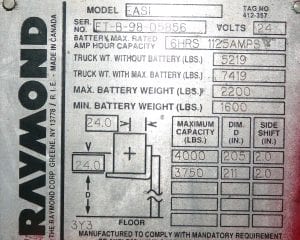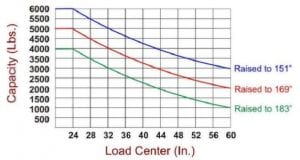Lately, I have noticed an increased focus on forklift specification plates from concerned warehouse  managers and from some administrators not necessarily in the know. I recently had a warehouse manager from a major beverage company request new spec plates as some were getting worn and hard to read. Another request came from an aircraft manufacturer procurement officer, who wanted to purchase fork extenders, but was unaware that the truck involved would have to get a new OSHA compliant updated specification plate. This applies to all classes of lift trucks, but I’ll focus on forklifts, as this is where such concerns commonly occur.
managers and from some administrators not necessarily in the know. I recently had a warehouse manager from a major beverage company request new spec plates as some were getting worn and hard to read. Another request came from an aircraft manufacturer procurement officer, who wanted to purchase fork extenders, but was unaware that the truck involved would have to get a new OSHA compliant updated specification plate. This applies to all classes of lift trucks, but I’ll focus on forklifts, as this is where such concerns commonly occur.
According to OSHA, every powered industrial lift truck must have a forklift specification plate. The primary focus is to help ensure that the truck is being safely and properly utilized for the application under consideration. Therefore, it is important to know the information that is available on the plate.
Forklift Capacity
First, the capacity must be legible or OSHA indicates it must be replaced. One cannot know the safety and usage limitations of a forklift’s capacity if they cannot read it. The plate must have certain safety details such as maximum capacity, load center, maximum fork height and truck weight. It is important that the forklift operator is trained on how to read and understand the plate.
The maximum capacity is the amount of weight the forklift is allowed to lift. There are a number of variances in loads and how it is positioned on the forklift. If the load is unevenly balanced on a pallet you might not be able to lift as much as the capacity shows, as maximum capacity assumes a centered load. If there is an attachment like a side-shifter, fork positioner, extender, clamp, etc., on the forklift it must be listed on the spec plate. In addition to adding dead weight and extending the load center, the attachment movements may have an effect on the safe lifting capabilities of the truck.
Load Center
Load center is the position of the center of gravity of the load as it’s positioned on the forks.
A 24” load center is very common. This means that the forklift is designed to pick up a load with a center of gravity 24” forward from the back of the forks and 24” up from the lifting surface. Think of it as half the distance of a perfectly balanced pallet that is four feet long and four feet tall when it is fully engaged on the forks.
Recently, I encountered a customer requesting a reconditioned truck with 7-foot forks. Immediately, this raised questions regarding the pallets being used and the weight and height to which it was being lifted. A heavier counterbalanced truck was going to be required because the load center was being moved out another 18” and the capacity of the truck would need to be downrated.
The information that is found on the plate includes the following:
- Mast and back tilt
- Truck weight without a load
- Truck weight w/o battery – battery weight to be added
- Max lifting height
- Attachments
- Load center
- Capacity
Maximum fork height is the distance from the ground to the lifting surface of the forks when the mast is fully elevated. A common max lifting height is 188” or 15’ 8”. While many taller fork heights are available, this mast configuration is about as high as you can go and still work in a typical trailer. The higher the maximum fork height, the taller the collapsed mast needs to be. Lift heights of 188” normally correlate to a collapsed height in the 85”-88” range, which is low enough to drive in and out of a full-sized box truck.
Truck Weight
The truck weight is another valuable detail listed on a specification plate. It’s important to know the weight when driving on floors inside over-the-road trucks. Understanding truck weight is fairly simple on an engine-powered forklift as it’s the total weight of the truck and attachment as listed on the plate. On a battery-powered forklift, the truck weight is the total weight of the truck and battery plus any attachments. Many are not aware of their forklift’s weight. Small lifts may weigh 6,000 lbs., medium sized lifts may weigh 10,000 lbs., and large lifts may weigh over 15,000 lbs. If a forklift truck is too heavy, it can puncture the floor.
For all these reasons, it is critical to know the capabilities and limitations of your forklifts and adhere to them. To help you do that, ‘Never forget that there is a lot on your plate.’




Leave a Reply
You must be logged in to post a comment.